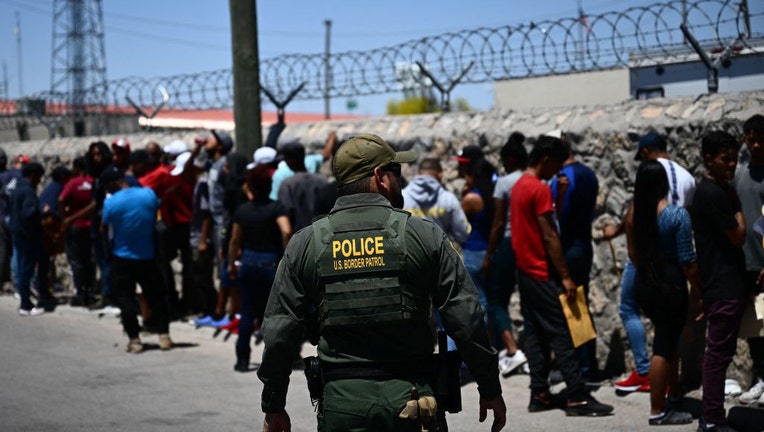"13,000 murderers" claim: Here's what ICE's numbers say about immigrants

FILE-A Border Patrol agent walks along a line of migrants waiting to turn themselves in to US Customs and Border Protection Border Patrol agents for processing near the Paso del Norte Port of Entry after crossing the US-Mexico border in El Paso, Texa
Immigration and Customs Enforcement released a report detailing immigrants under the agency’s supervision who were either convicted of a crime or facing criminal charges. Data included in the report shows that more than 13,000 migrants were convicted of homicides.
Donald Trump, who has depicted immigrants as bringing lawlessness and crime to America, tweeted multiple screenshots of the data with the words: "13,000 CROSSED THE BORDER WITH MURDER CONVICTIONS."
The Republican presidential candidate suggested that the numbers correspond to President Joe Biden and Vice President Kamala Harris' time in office, the Associated Press reported.
However, the Department of Homeland Security, which supervises ICE, explains that the statistics in the report are misinterpreted, with the agency telling the Associated Press that the data covers decades — including the Trump administration and other presidencies — and immigrants not in ICE custody who may be held by a state or local agency.
RELATED: Immigration and Border Security: Harris vs. Trump
Homeland Security also emphasized what the agency has done to deport those without the right to stay in the U.S., telling the AP it has removed or returned more than 700,000 immigrants in the past year, which it said was the highest number since 2010. The agency said it had removed 180,000 people with criminal convictions since President Joe Biden took office.
ICE made the stats available and sent a letter to Republican Rep. Tony Gonzalez, who made a request for information. The letter listed figures on immigrants with criminal records being tracked by ICE but not detained by the agency.
With immigration being a key issue in the 2024 presidential election, the GOP is focusing on ICE data to support their assertion that the Biden administration is allowing migrants who have committed serious crimes to go free in the U.S.
Harris at the border: immigration & 2024 politics
The border is a top issue ahead of the 2024 election, with both GOP candidate Donald Trump and his running mate JD Vance making multiple stops in the last few months. Stephanie Murray is a national politics reporter for AZCentral. She was on scene as Vice President Harris visited the border, and joins LiveNOW from FOX.
What does the ICE data reveal?
As of July 21, ICE said 662,556 people under its supervision were either convicted of crimes or face criminal charges. Almost 15,000 were in its custody, but the vast majority — 647,572 — were not.
Included in the figures of immigrants not detained by ICE were people found guilty of very serious crimes: 13,099 for homicide, 15,811 for sexual assault, 13,423 for weapons offenses and 2,663 for stolen cars.
RELATED: Keeping Families In Place: Biden’s new immigration policy opens, what to know
According to the AP, the single biggest category was for traffic-related offenses at 77,074, followed by assault at 62,231 and dangerous drugs at 56,533.
Millions of immigrants are on ICE's "non-detained docket," or immigrants under the agency's supervision who aren't in its custody. The AP noted that many migrants are awaiting the results of their cases in immigration court, and others have been released after completing their prison sentences because their countries won’t take them back.
Can ICE deport criminals?
The agency has limited resources, with the AP reporting that the number of migrants it supervises has increased, while its staffing dwindled. Citing a 2023 end-of-year report from ICE, the AP noted that the agency has to send staff to help at the border, taking them away from their normal duties.
RELATED: Mexico's increase in immigration enforcement results in drop in illegal border crossings into US
The number of migrants that ICE supervises but who aren't in its custody has risen from 3.3 million a little before Biden took office to a little over 7 million last year.
Moreover, ICE also has legal limits on who they can hold. The agency’s budget allows them to hold 41,500 people at a time. John Sandweg, who was acting ICE director from 2013 to 2014 under then-President Barack Obama, told the AP that holding people accused or convicted of the most serious crimes is always the top priority.
But once someone has a final order of removal — meaning a court has found that they don't have the right to stay in the country — they cannot be held in detention forever while ICE determines how to get them home.
The AP reported that a 2001 Supreme Court ruling prevented ICE from holding those individuals for over six months if there is no reasonable chance to expect they can be sent back.

